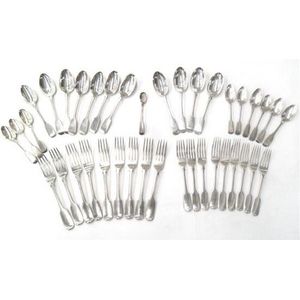Art Deco Diamond and Ruby Ring
You must be a subscriber, and be logged in to view price and dealer details.
Subscribe Now to view actual auction price for this item
When you subscribe, you have the option of setting the currency in which to display prices to $Au, $US, $NZ or Stg.
- Collet Setting - A collet setting in jewellery is a type of setting that is used to hold a gemstone or other decorative element securely in place. The collet is a ring of metal that surrounds the stone and holds it in place. The collet is typically made of the same metal as the rest of the piece and is often used in vintage or antique jewellery.
In a collet setting, the gemstone is placed into a small metal ring, also known as a collet. The metal ring is then bent or folded over the edges of the gemstone to hold it securely in place. The collet is then attached to the rest of the piece of jewellery, such as a ring or pendant.
One of the benefits of a collet setting is that it allows the maximum amount of light to enter the stone, which can enhance its brilliance and sparkle. It also allows the stone to be seen from the sides, which makes it a popular choice for showcasing particularly beautiful or unique stones.
The collet setting is a classic and elegant setting and it is often found in antique jewellery, particularly from the Victorian and Edwardian periods. - Brilliant Cut - In their naturally occuring state diamonds have little life or sparkle and for many centuries were simply cut in half and worn in amulets. Invented at the end of the 17th century by a Venetian diamond cutter, a "brilliant cut" diamond has 58 facets arranged in a regular geometric relationship, with 33 above the crown and 25 below on the pavilion.
The introduction of the brilliant cut increased the popularity of diamonds in jewellery as it was the first cut to reveal the fire of the diamond, with the light being internally reflected from one facet to another, and was superior to the previously used table cut and rose cut.Variants to the brilliant cut have emerged since the end of the 17th century, but the popularity of the original brilliant cut has continued to the present time, where it is still the most commonly found cut.
. - Rose Cut - A flat based cut for a preious stone, leaving the surface covered with triangular facets, usually 24 in total.
It was introduced in the 15th century and popular during the 16th and 17th centuries.
The rose cut was the most popular form of diamond cut until the discovery of the brilliant cut at the end of the 17th century, after which its use declined. - Art Deco Period - The Art Deco period was a cultural movement that emerged in the 1920s and 1930s, and was characterized by its emphasis on modernism, luxury, and elegance. The name "Art Deco" comes from the Exposition Internationale des Arts Décoratifs et Industriels Modernes, a large exhibition held in Paris in 1925 that showcased the latest trends in decorative arts.
Art Deco was a reaction against the ornate and elaborate styles of the previous era, and reflected a new modern sensibility. It was characterized by streamlined, geometric shapes, bright colours, and the use of new materials such as chrome, glass, and Bakelite. Art Deco designers sought to create a sense of luxury and sophistication, often incorporating expensive materials such as ivory, marble, and rare woods.
Art Deco had a significant impact on a wide range of artistic fields, including architecture, fashion, graphic design, and interior design. Some of the most iconic examples of Art Deco architecture include the Empire State Building in New York City, the Hoover Building in London, and the Palais de Chaillot in Paris.
The Art Deco period came to an end in the 1940s, as World War II and changing cultural trends led to a shift in artistic styles. However, Art Deco remains an important influence on design and art, and continues to be celebrated for its modernist sensibility and glamorous aesthetic.
This item has been included into following indexes:
Visually similar items

A pre-war Marklin O gauge clockwork 4-4-0 E920 locomotive and tender

A William Moorcroft early Pansy design vase, baluster form, the encircling band of decoration with white glaze above and cobalt blue below, full signature in green and impressed marks to the base. Height 19 cm.

An English sterling silver fiddleback part cutlery set, 1838-1875, various makers, including: eleven dessert spoons, London, 1875, JW&Co for Josiah Williams & Co & London, 1838,3 MC for Mary Chawner, nine teaspoons, Exter, 1865, JW&JW for Joshiah & James W

A basket attributed to Minton, circa 1835, the shaped rectangular basket with moulded foliate edging and a cross over moulded handle, decorated with gilt wriggle work on a cobalt ground centred with a gilt cartouche enclosing fancy birds in colours, unmark
